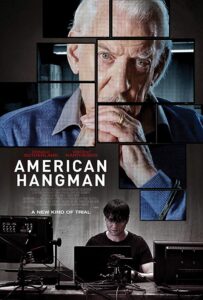Donald Sutherland elevates “Saw-lite” material.


At least writer/director Wilson Coneybeare is in on the joke. Early in “American Hangman,” one of the characters tells the learned, retired Judge Straight that the situation reminds him of a movie, one that came down to sawing off a “flipper” to survive. Naturally, the reference is to “Saw,” a movie that no doubt inspired this lighter, contained thriller.
The setup is known to us. A mysterious killer kidnaps two men with no obvious connection to one another and plays an elaborate game with them. The captor (played by Vincent Kartheiser) is named Henry, a reference that should be lost on no true cineaste. Henry is pretty handy with computers and cameras and has outfitted a concrete-walled basement into a makeshift courtroom. The “trial” will be televised to the world via the Internet.

After proving that he’s a serious man, committing an act of violence that cements his ruthless tendencies, Henry sets the rules of the game. His main captive is Judge Straight (Donald Sutherland), a retired jurist, who had presided over the trial of a murderer recently put to death. But Henry asks the Judge and anyone watching whether the man actually committed the crime.
Working from the premise of a wrongful conviction, Henry intends to put the Judge and the justice system on trial, and we, the public, shall be the jury. Voting has been set up “American Idol” style, subject to the whims of social media taste. And once word gets out about the streaming event, viewership explodes. We are periodically reminded of the viewing numbers with a graphic.

What sounded like a derivative bit of nonsense proves to be engrossing, as Henry and the Judge spar over various legal and moral questions. The action inside the basement unfolds as the authorities and the media wrestle with their own complicity. Coneybeare’s script is fairly sharp and paced well, if, at times, subject to moments of cliche. But at the center of the action is another in a long line of terrific performances from Sutherland, whose presence takes the entire production up a notch or two.
It can’t be overemphasized the effect Sutherland has on this little film. For almost the entire running time, the famous actor sits in a chair and converses with Henry. In fact, Sutherland never leaves the basement. This illustrates how the producers were able to afford such talent. Sutherland must have worked on this modestly budgeted production just a few days, and yet, he’s featured substantially and delivers powerfully. This is not a throwaway cameo intended to help sell the movie, it’s a full-bodied role and Sutherland bites hard enough to keep us watching.

Not only does Sutherland’s commitment to the familiar material help Kartheiser with a role that requires him to look down and hide his face the entire time, but everyone else steps up their game. Oliver Dennis is a standout as a police Lieutenant set to retire on the very day of the kidnapping. Dennis solidly inhabits the role that gives him time to emote and riff about his years as an officer. Sure, the whole affair gets a bit preachy, but it’s really well-done.
References to other movies can be spotted throughout. Naming the killer Henry might refer to “Henry: Portrait of a Serial Killer.” And Coneybeare even includes a subtle homage to “Assault on Precinct 13,” in that the existing police headquarters are set to be shut down and moved to a newer facility. This wink and a nod is not distracting, rather, it is interesting to see what the script is doing with the ideas.
“American Hangman” works despite its unoriginal origins. And if you’re going to embrace formula and cliche, it helps to have great talent shepherding your screenplay and crafting the characters on screen. The Sutherland effect cannot be dismissed.
